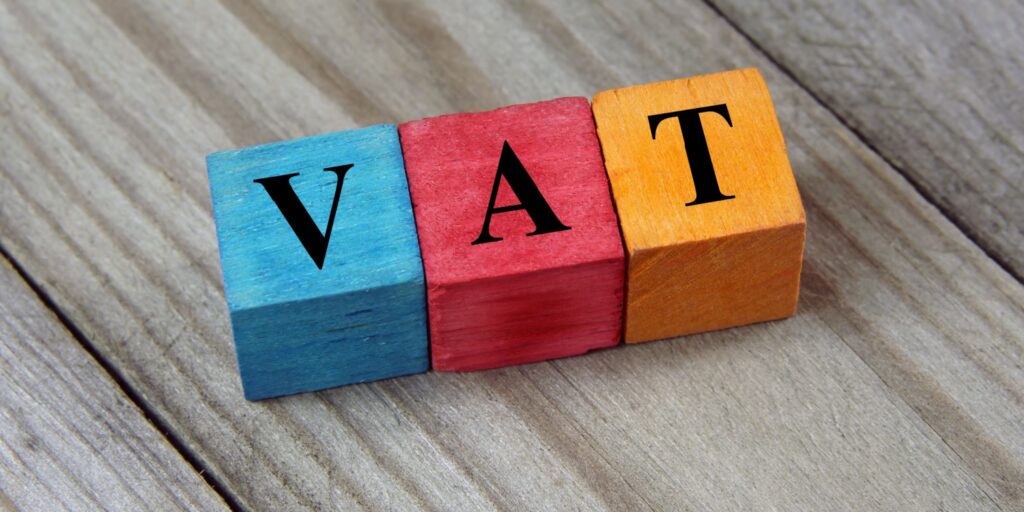The VAT registration threshold is the turnover threshold at which businesses are legally required to register for VAT in the UK. It is set at £90,000. This is the taxable income your business can earn in a specified period before VAT registration becomes compulsory.
Whether you’re self-employed or trading through a limited company, it’s essential to understand the rules on VAT registration and keep track of your taxable turnover. This post explains everything you need to know, including how and when to register for VAT if the need arises.
The VAT registration threshold
The UK VAT threshold, also known as the VAT registration threshold, dictates when businesses making taxable supplies or relevant acquisitions must register and account for VAT (Value Added Tax).
On 1 April 2024, the threshold was increased from £85,000 to £90,000 per year. It remains at this level for the 2025-26 tax year.
As a business owner, you have a legal obligation to register for VAT in the UK if either of the following applies:
- at the end of any month, your taxable turnover in the past 12 months exceeds the current VAT threshold
- at any time, you expect your taxable turnover to exceed the VAT threshold in the next 30 days alone
Taxable turnover is the total value of the goods or services you sell in the UK that are not VAT-exempt or outside the scope of VAT. When you sell (or otherwise supply) taxable goods or services in the course or furtherance of business, you are making ‘taxable supplies’.
Acquisitions VAT threshold in Northern Ireland
The VAT registration threshold for acquisitions into Northern Ireland is also £90,000 for the current tax year.
If your business is based in Northern Ireland and you buy goods from VAT-registered EU suppliers, you must register for VAT if either:
- at the end of any month, the total value of those relevant acquisitions in the year, or part of the year, from 1 January has gone over the registration threshold
- it is reasonable to assume that the value of the relevant acquisitions you will make in the next 30 days alone will exceed the registration threshold
This requirement applies if your business sells only VAT-exempt or ‘out of scope’ goods in Northern Ireland. It does not apply to the purchase of services.
Distance selling to or from Northern Ireland
The current VAT registration threshold for distance selling to or from Northern Ireland is £8,818. You must register for VAT in the UK if all of the following apply:
- your business is based in an EU Member State
- you supply and deliver goods to customers in Northern Ireland
- the total value of those sales exceeds the distance selling VAT threshold at any time during the calendar year from 1 January
If your business is based in Northern Ireland and you sell goods to consumers in the EU, you must register for VAT in EU countries when the total value of those distance sales exceeds £8,818.
When the VAT registration threshold doesn’t apply
If you make distance sales into the UK of excise goods (e.g. tobacco or alcohol), you are liable to register for VAT regardless of the value of those supplies.
The UK VAT threshold also does not apply if you meet the following three conditions:
- you are based outside the UK
- your business is also based outside the UK
- you make taxable sales of goods or services in the UK, or you expect to do so in the next 30 days
In this situation, you are a ‘non-established taxable person’ (NETP) for the purposes of UK VAT. You must register for VAT regardless of your level of turnover.
What are taxable supplies?
Taxable supplies are any goods or services you supply in the UK other than those which are VAT-exempt or ‘out of scope’. They include:
- goods you sell that are taxable at the standard rate, reduced rate, or zero rate of Value Added Tax
- goods that you hire out or lease to customers
- any business goods you use for personal reasons
- goods that you give away, part-exchange, barter, or offset
- services you receive from businesses overseas that you have to ‘reverse charge’
- goods and services you receive that are subject to the ‘domestic reverse charge’
- building work over £100,000 in value that your business undertakes for itself
For VAT purposes, the total value of your taxable supplies determines your taxable turnover.
How to calculate your taxable turnover
Your taxable turnover dictates both your liability to register for VAT and your eligibility to apply for cancellation of VAT registration.
As a business owner, it’s important to monitor your taxable turnover on a rolling 12-month basis rather than over the calendar year, tax year, or the financial year covered by your annual accounts.
In practice, this involves calculating the value of your taxable supplies for the past 12 months at the end of every month. If your taxable turnover is more than £90,000 at the end of any 12-month period, it’s time to register for VAT.
What’s the deadline for compulsory VAT registration?
If you exceed the VAT registration threshold or realise that you’re about to, you’ll have at least 30 days to register for VAT. The exact amount of time depends on the situation.
Scenario 1 – You’ve exceeded the VAT threshold in the past 12 months
If your total VAT-taxable (or ‘VATable’) turnover for the past 12 months is more than £90,000, you need to register within 30 days of the end of the month you exceeded the threshold.
Your ‘effective date of registration’ for VAT will be the first day of the second month after you exceed the threshold.
For example:
- On 25 July, your turnover for the past 12 months reached £91,000
- That is the first time your turnover has gone over the VAT threshold in any 12-month period
- You are legally required to register for VAT on or before 30 August
- Your effective date of registration will be 1 September
Scenario 2 – You are going to exceed the threshold in the next 30 days
If it becomes apparent that your total VATable turnover for the year will exceed the £90,000 threshold in the next 30 days, you must register by the end of those 30 days.
Your effective registration date will be the date you realised this was going to happen, not when your turnover exceeds the threshold.
For example:
- On 1 September, you secure a new contract for services worth £91,000
- The client will pay you at the end of September
- You must apply for VAT registration by 30 September
- Your effective date of registration will be 1 September
Other scenarios – distance sales, relevant supplies, and NETPs
- If the value of your distance sales exceeds the threshold – register within 30 days of the date this happens
- When you make relevant supplies – register within 30 days of making the supply
- If you believe you will make a relevant supply in the next 30 days – register before the end of these 30 days
- If you’re a non-established taxable person and you make taxable supplies in the UK of any value – register within 30 days of the date you make the supply
- You’re a NETP and you expect to make taxable supplies in the UK in the next 30 days – register within 30 days of when that expectation arose
What happens if my turnover goes over the threshold temporarily?
You can apply to HMRC for a registration ‘exception’ if your VATable turnover temporarily exceeds the threshold. There are many reasons why this might happen, for example:
- you received unusually large orders from one or more customers
- you completed a hefty contract on a one-off basis
- there was a sudden increase in your sales due to marketing or seasonal fluctuations
To apply, you need to request the VAT1 registration form from HMRC. When you return the form, you must include evidence showing that your taxable turnover won’t exceed the VAT deregistration threshold of £88,000 again in the next 12 months.
If you get an exception, HMRC will confirm this in writing. However, if you do not, they will register you for VAT instead.
Exemption from VAT registration
You may be exempt from VAT registration if most of your taxable supplies have a VAT rate of 0%. These goods and services are known as zero-rated supplies.
If you’re a NETP, you are eligible for exemption from registration if you sell only zero-rated goods or services.
You can apply for VAT exemption in one of two ways:
- Online – using HMRC’s online VAT registration service
- By post – contact HMRC and request the VAT1 registration form
To complete the application, you must provide information about your business, including the estimated value of your zero-rated supplies over the next 12 months.
HMRC will contact you in writing if your application for exemption is approved. If it’s rejected, they’ll register you for VAT instead.
VAT accounting scheme thresholds
In addition to the VAT registration threshold, you may need to consider other thresholds for using certain VAT accounting schemes. Several schemes are available that allow eligible businesses to manage their VAT accounting in different ways. They are all optional.
Flat Rate Scheme threshold
The VAT Flat Rate Scheme is designed to simplify your record keeping and help you manage your cash flow. It allows you to pay HMRC a fixed rate of VAT, which is lower than the standard rate
You get to keep the difference between the VAT you charge your customers and what you pay to HMRC. However, you can’t reclaim the VAT on your purchases other than certain capital assets over £2,000.
The threshold for the Flat Rate Scheme is £150,000 or less. Your estimated taxable turnover in the next year must be £150,000 or less to join.
The threshold to leave the scheme is £230,000. If your turnover exceeds that amount, you must leave the scheme.
Cash Accounting Scheme threshold
The VAT Cash Accounting Scheme allows you to pay VAT on your sales (output tax) based on when your customers pay you rather than when you invoice them.
Similarly, you can only reclaim VAT on your business purchases (input tax) when you pay your suppliers rather than when they invoice you.
The threshold for the Cash Accounting Scheme is £1.35 million or less. To join this scheme, your estimated taxable turnover in the next year must be £1.35 million or less.
The threshold to leave the scheme is £1.6 million. If your turnover exceeds that amount, you must leave the scheme.
Annual Accounting Scheme VAT threshold
Under the VAT Annual Accounting Scheme, businesses submit only one VAT Return each year and make advance payments towards their VAT bill. Ordinarily, businesses submit a return every three months and pay their VAT bill simultaneously.
The threshold for the Annual Accounting VAT Scheme is £1.35 million or less. To join this scheme, your estimated taxable turnover in the next year must be £1.35 million or less.
The threshold to leave the scheme is £1.6 million. If your turnover exceeds that amount, you must leave the scheme.
How to register for VAT in the UK
You can apply for VAT registration with HMRC online or by post. The process is largely the same whether you are registering as a limited company, a partnership, an individual (e.g. a sole trader), or a non-established taxable person.
To register online, you must sign in to your HMRC account with your Government Gateway user ID and password. If you don’t yet have an online account, you can create one as a new user.
Next, you will answer a series of questions about your business, including why you are applying to register for VAT. You will then provide information about yourself and your business, including (where applicable):
- company registration number
- primary place of business – i.e. your registered office address or business address
- description of business activities
- Unique Taxpayer Reference (UTR) for your company or partnership
- personal details, including your name, address, date of birth, National Insurance number, and individual (personal) UTR
- details of annual turnover
- an identity document – e.g. a passport or driving licence
- the date on which you exceeded (or you expect to exceed) the threshold
When registering a partnership for VAT, you must also complete form VAT2 to provide details of each partner. You need to upload this to your application.
If online registration is not possible, you can register for VAT by post using the VAT1 paper form.
After registration
If HMRC accepts your application, you should receive the following information by post within 30 days:
- your VAT certificate, which will contain your unique 9-digit VAT registration number
- guidance on setting up your business tax account (if you don’t have one already) – you’ll need this to access HMRC’s VAT online service
- information about when to submit your first VAT Return and payment
- confirmation of your VAT registration date – this is known as your ‘effective date of registration’
When this information arrives, you must sign up for a VAT online account. To do so, follow these simple steps:
- Sign in to Government Gateway with your user ID and password
- Click on ‘Business tax account’ from the menu bar along the top
- Select ‘add a tax, duty, or scheme’ – it may appear as ’get online access to a tax, duty, or scheme’ if you’re signed up for other taxes already
- Select ‘VAT and VAT Services’
- Choose which services you want to add
- Enter your VAT number
- Provide the date you became VAT-registered – this is shown on your certificate
- Enter the UK postcode where your business is registered for VAT
You will use this account to manage your VAT affairs, including viewing how much you owe and paying your VAT bills. If you use the Annual Accounting Scheme, you can also submit your VAT Return through your online account.
Can I register for VAT if my turnover is below the threshold?
Voluntary VAT registration is available to small businesses with taxable turnover below the VAT registration threshold. The application is exactly the same as outlined above.
There are several benefits to voluntary registration. Most notably, you can reclaim the VAT you pay on purchases, appeal to prospective clients or customers who are also VAT-registered, and boost your business profile and credibility.
What is the VAT deregistration threshold?
The VAT deregistration threshold is £88,000 (or £90,000 if your business is in Northern Ireland). If your taxable turnover falls below the applicable threshold (or you know it’s going to), you can apply online to cancel your VAT registration.
However, doing so is optional – you can continue being registered for as long as you like. Deregistration is only compulsory when a business is no longer eligible to be VAT-registered – e.g. if it ceases trading or stops making taxable supplies.
Thanks for reading
Knowing the VAT threshold and understanding the rules on VAT registration are crucial for small business owners. If your level of taxable turnover is close to the threshold, you should monitor it on a rolling 12-month basis. Doing so will enable you to register for VAT within the required timeframe if or when the need arises.
Please note that the information provided in this article is for general informational purposes only and does not constitute legal, tax, or professional advice. While our aim is that the content is accurate and up to date, it should not be relied upon as a substitute for tailored advice from qualified professionals. We strongly recommend that you seek independent legal and tax advice specific to your circumstances before acting on any information contained in this article. We accept no responsibility or liability for any loss or damage that may result from your reliance on the information provided in this article. Use of the information contained in this article is entirely at your own risk.














Join The Discussion
Comments (2)
Thanks for simplifying and explaining the VAT registration threshold in UK. This info will be useful for my own team of professional UK accountants.
Thank you for your comment, David. We’re glad the article was helpful!
Kind regards,
The 1st Formations Team